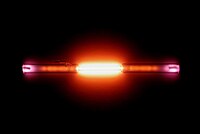
Photo from wikipedia
Helium line intensities have been utilized to measure the electron density, n e , and temperature, T e , by comparing measured line intensities to a collisional-radiative model (CRM). In… Click to show full abstract
Helium line intensities have been utilized to measure the electron density, n e , and temperature, T e , by comparing measured line intensities to a collisional-radiative model (CRM). In this study, we use multiple regression analysis to train a model of the helium line intensities and n e /T e obtained from a Thomson scattering system in the linear plasma device Magnum-PSI; based on the trained model, we predict n e and T e from line intensities. We show that this method can also obtain radial profiles of n e and T e . We discuss appropriate selections of line pairs for the prediction based on the multiple regression analysis. A big advantage of this method against the standard technique using CRM is that modeling of atomic population distributions is not required, which sometimes needs to take into account various effects such as radiation trapping, transport of helium atoms in metastable states, etc.
Journal Title: Plasma Physics and Controlled Fusion
Year Published: 2021
Link to full text (if available)
Share on Social Media: Sign Up to like & get
recommendations!